 When it comes to the length of your school’s marketing content, it’s natural to assume that less is more. After all, in the fast-paced, digital world we live in, prospects simply don’t have the time or attention span for sprawling in-depth articles. With so much else out there competing for their attention, content needs to be snackable, simple, and straight to the point. Right?
When it comes to the length of your school’s marketing content, it’s natural to assume that less is more. After all, in the fast-paced, digital world we live in, prospects simply don’t have the time or attention span for sprawling in-depth articles. With so much else out there competing for their attention, content needs to be snackable, simple, and straight to the point. Right?
So why then, in 2019, has the average length of a top-ranking blog post on Google risen to 1,890 words?
Against the odds, long-form content is thriving in the condensed online ecosystem, with brands in all fields finding success going against the grain and producing comprehensive pieces that offer exhaustive information about all kinds of topics.
But could this tactic be used by schools? Are some already doing it? And what sort of role can long-form content play in your overall digital marketing strategy? Read on to find out.
Why Does Long-Form Blog Content Work?
People’s definition of long-form content tends to vary depending on what they consider the normal length for their blogs, with some considering anything to goes beyond the journalistic standard of about 750 words to be long-form, while others only apply the label to posts which pass the 2,000 or even 3,000-word mark.
However you define it, though, it is clear that Google now favours longer posts in results, and that is no accident. The search engine’s remit is to provide the most accurate answers possible to the queries it is being posed by users. A longer post will contain more information, meaning it is more likely to offer what a user wants.
As a result, Google has moved more and more towards rewarding depth in its algorithms over the past number of years. In a 2013 article, Pandu Nayak – architect of the Panda algorithm update – noted that the company’s “research suggests that up to 10% of users’ daily information needs involve learning about a broad topic. That’s why today we’re introducing new search results to help users find in-depth articles.”
This has resulted in the average length of top-ranked pages increasing by over 200% over the course of seven years – although it should be noted that it has now dropped slightly from its 2,400-word peak in 2016.

Aside from the depth it offers, longer content also affords other potential SEO benefits. For a start, longer pieces can allow you to integrate more internal links to your other web pages naturally throughout your pieces.
This improves the overall SEO health of both the long-form post and the pages its links to, creating a reciprocal relationship that strengthens their authority in unison. The recent trend towards the ‘cluster model’ of content creation, with long-form pillar pages at its centre, is arguably a direct result of the increased popularity of long-form content.
Long-form content also provides more opportunities for natural keyword integration, and even the chance to include multiple CTAs in a single page by placing them mid-page as well as at the end of your piece.
In addition, a HubSpot study found that longer articles tended to attract more backlinks than average:

The same study found a similar correlation between length and social shares:
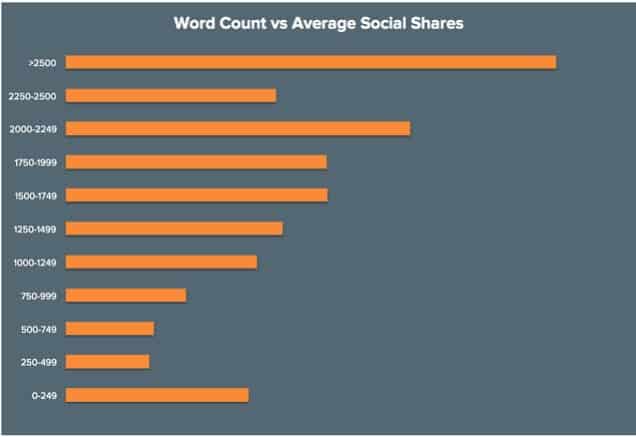
Aside from its SEO benefits, long-form content also represents an opportunity to explore topics your target personas care about in real depth, and provide something that offers true, lasting value for prospective applicants.
And while the popular consensus is that most internet users prefer short, digestible content, the statistics don’t necessarily bear this out. In fact, research by Medium into user engagement with pieces on its platform found that the ideal read time for holding attention and engagement was about seven minutes, which equates to around 1,600 words.
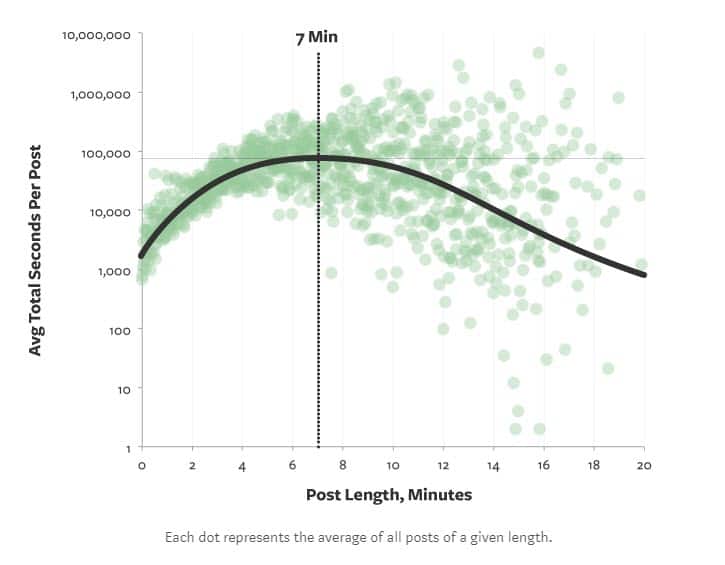
Long-form Higher Education Content Ideas
So how can schools generate ideas for long-form higher education content marketing? For the most part, that will largely depend on what type of institution you are, and what kind of resources you have at your disposal. Universities, for instance, should expect to have no shortage of material for long-form pieces, with a wealth of academic research, expert opinions, and complex subject matter to tap into. These kinds of articles can give prospects a clearer picture of what they can expect to learn while studying at your school and, if done well, can even ignite their passion about a particular subject area.
Example: The London School of Economics and Political Science maintains a series of in-depth blogs around different academic fields, featuring cutting edge research and expert analysis. This 1,800-word post from one of the school’s sociology lecturers explores research into the correlation between religion and political preferences for the Religion and Global Society blog.

While other kinds of institutions like language schools, k-12s, and smaller colleges won’t have quite the same level of content to draw on in this area, that doesn’t mean it isn’t an option for them. Small-scale case studies, expert articles from faculty, or even just more in-depth introductory pieces about specific topics can all have value for small schools if executed well. The fact that this tactic might be more unusual at this level could even give you an edge over your competition.
That isn’t to say that all of your long-form content should be academic. On-campus events, activities, and trips can all lend themselves well to a more detailed in-depth treatment provided the material tells an engaging story.
Example: This 1,400-word piece on The University of Notre Dame’s website highlights one of the volunteer experiences the school offers for students.

In addition, long-form articles can be especially valuable if you are looking for ways to highlight your current students or alumni. Provided you do the necessary groundwork, interviews can be turned into long-form ‘profile’ pieces that really get to the heart of your student’s stories and what they gained form studying with you. You might even be surprised by some of the extraordinary stories your school community has to tell.
Example: Marquette University makes excellent use of blogging platform Medium to publish long-form content that showcases its students’ achievements. This piece about female alumni in sports journalism features five Marquette graduates and clocks in at just over 2,000 words.
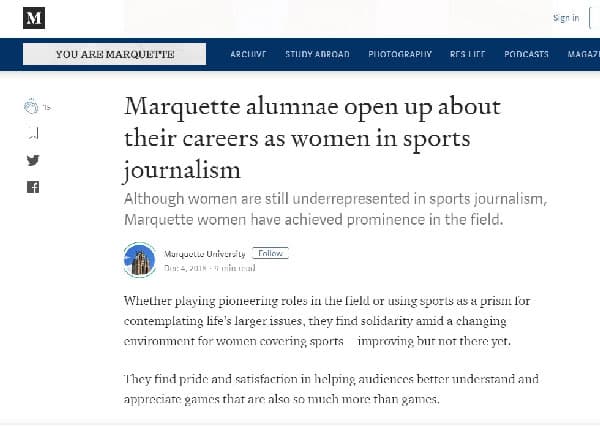
It’s also important to remember that long-form doesn’t necessarily mean you have to write complex, high-brow thinkpieces. Many content creators pursuing the strategy will continue to produce relatively simple articles if that’s what their audience prefers; they will simply do it on a larger scale. For instance, you might create a blog using the ‘listicle’ format about things to do in your location, and simply add more items to the piece than normal.
Example: This blog from EF English entitled “50 things we love about the US (and know you’ll love too)” is over 2,200 words long, but is still written simply in order to remain accessible for an international audience.
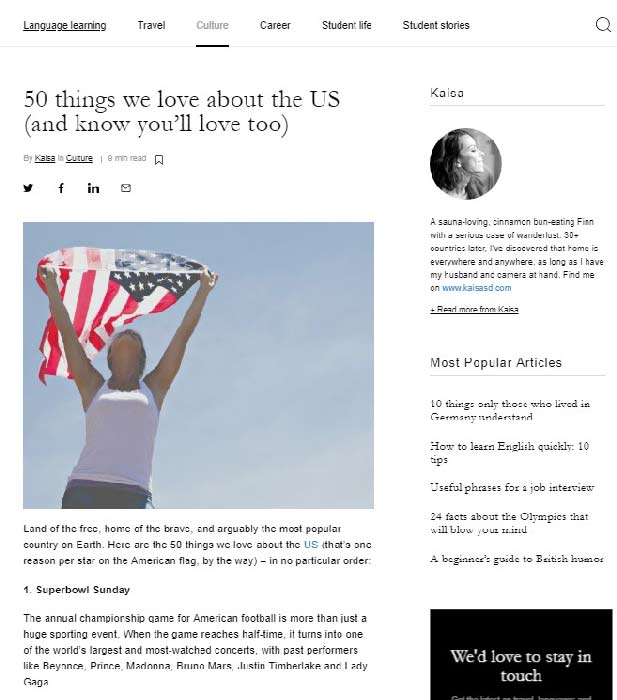
The key, as always, is to keep your target personas in mind, and let their needs and preferences drive what long-form content should look like for your school. From there, you can integrate it seamlessly into your overall higher education content marketing strategy.
The Importance of Structure in Long-Form Higher Ed Content
While statistics show that internet users value good long-form content, they may still be put off by the idea of devoting several minutes of their time to a reading a lengthy article. In many cases, how you present your posts will be the key to convincing them to make the effort.
First, a long-form post needs to be easily scannable. Breaking it into small sections – using clearly labelled headings – will allow readers to glean an idea of the article’s contents at a glance. This will help reassure them that the content is worth their time, and will provide what they are looking for. Once they begin reading, this structure will also help the piece flow better, and make it easier for them to absorb the information.
Example: This blog about things to do in Vancouver from EC English is fairly long for a language school audience, but the school makes it easy to navigate by structuring it well. There is a section for each season, with each activity or attraction listed under its own subheading. The school also highlight tips in larger lettering in between paragraphs.
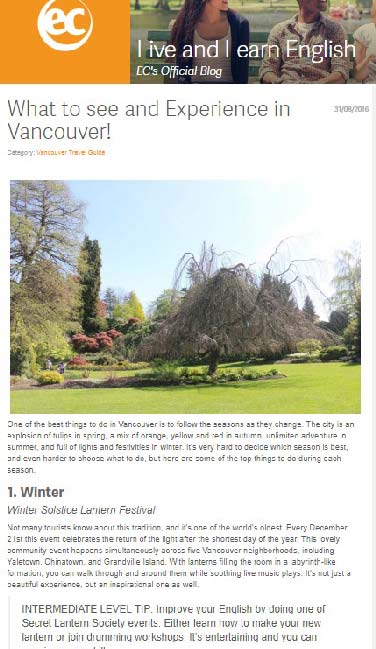
You should also pay attention to your paragraphing. Generally, internet content experts recommend making most of your paragraphs around three sentences long. Larger paragraphs can create blocks of text which can be intimidating or off-putting for readers.
Additionally, you should use visuals to break up your long-form blogs. CoSchedule found that its posts performed better when they included an image every 200 words, which could be a good rule of thumb for your school to follow.
Combining these elements will help your school to produce posts which are visually pleasing, navigable, and enticing for prospects, increasing your chances of them reading more.
When Long-Form Isn’t The Answer in Higher Education Content Marketing
While the benefits of long-form content are clear, it isn’t something you should do just for the sake of it. For one thing, creating longer articles means more research, more writing and more editing, which can put a strain on your resources. It’s arguably still more beneficial to create shorter posts regularly and in large volumes than it is to publish long-form pieces on an irregular or occasional basis. If you think you might find it difficult to create in-depth blogs on a regular schedule, then your school may have a tough choice to make.
Additionally, it is possible that long-form content just isn’t that suited to your target personas. Simply put, if they are more likely to respond to shorter, more concise blogs, that is exactly what you should be producing for them. Those targeting international students in particular should tread carefully when considering lengthier posts, unless they are being translated into the language of your audience.
Long-form pieces may also not align with your higher education content marketing goals. The Write Practice founder Joe Bunting believes that long-form content is primarily beneficial if your aim is to improve search rankings, while medium length posts are better if you are looking to attract social shares and backlinks, and short posts of under 300 words are actually best for attracting comments and generating discussion. In the end, it depends on what you ultimately need to achieve.
Above all else, though, what you need to ask yourself before creating long-form posts for your school is whether the topic you are writing about warrants this kind of piece. The insights and value your prospects gain from reading it should be enhanced by the increased length. If there isn’t enough substance to the subject matter for a quality long-form piece, it could veer off-topic, become repetitive, or simply come across as rambling and unfocused.
Long-form content isn’t for everyone, and may not be the right choice for your school and its needs, particularly if you are already enjoying good online visibility. If you can do it well, though, it could be a great addition to your overall strategy, helping you to increase both traffic and engagement with your website from prospective students. And when it comes to that, more is definitely better.








